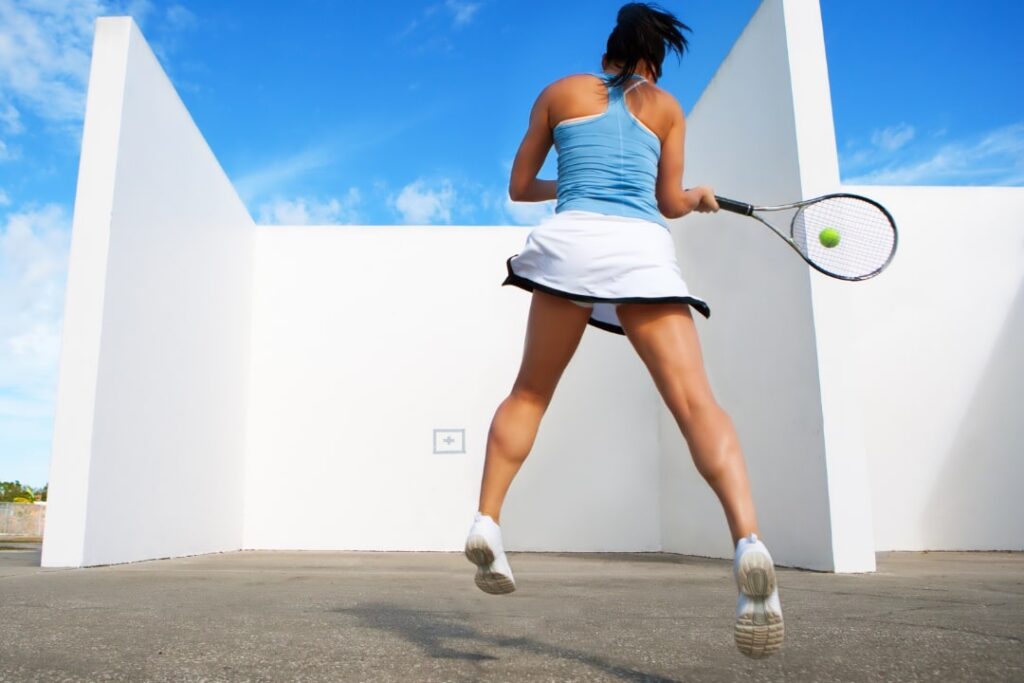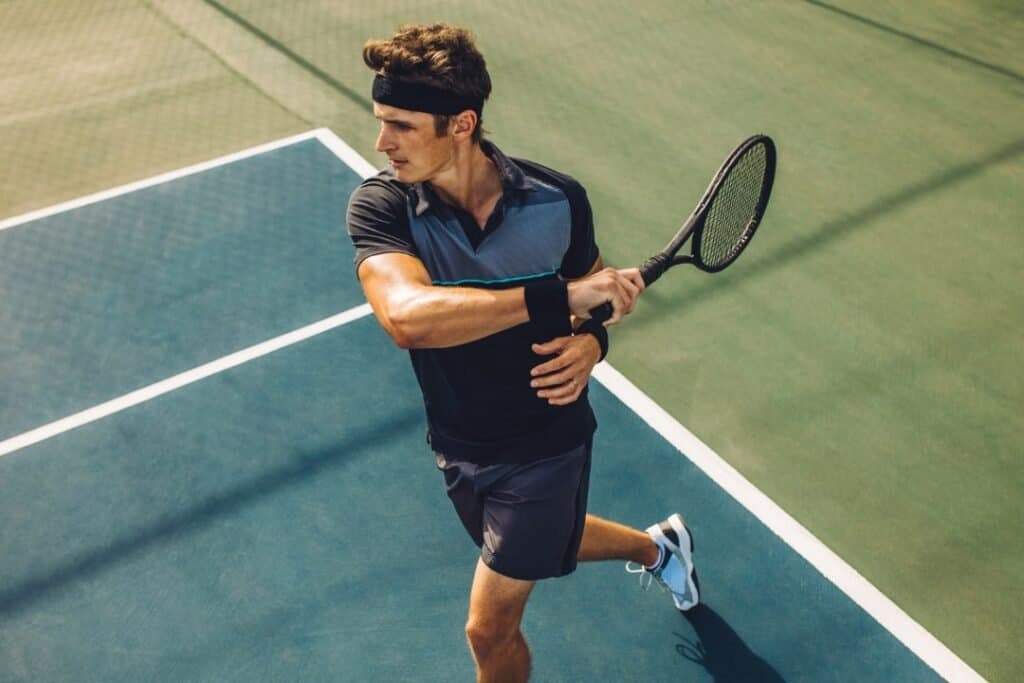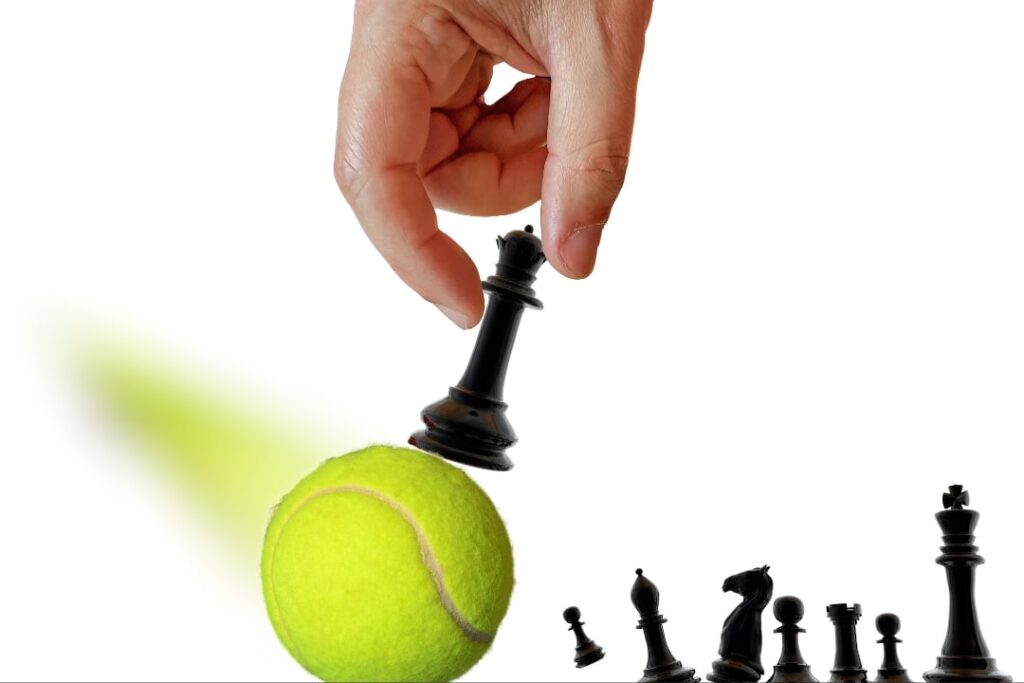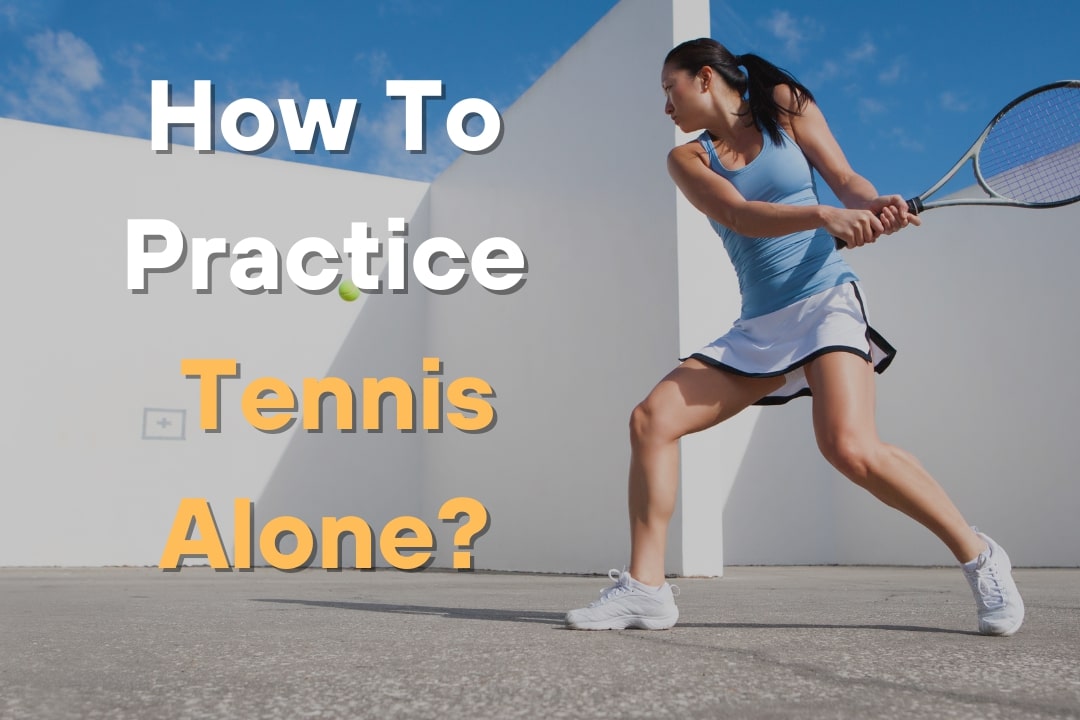Tennis is a sport that is always played by at least two players. But finding a tennis partner can be difficult at times, as most people are busy. But luckily, solo practice can be as beneficial or even more effective than practicing with someone else.
You can practice tennis yourself using training aids such as a ball machine to work on specific shots you want to train on. Other than using tools, you can also use a wall or self-feed the balls yourself. You can also practice your serve without a partner or work on your footwork and conditioning.
What are the most effective ways to practice tennis by yourself? Here are 11 ways on how to practice tennis alone:
Table of Contents
1. Play Against The Wall or Backboard

Playing tennis against the wall is actually a very common training method. It is surprisingly effective in improving your strokes, reflexes, footwork, endurance, and more.
So, what are the benefits of practicing tennis against the wall?
Unlike human players, the wall never misses a return shot. Your stamina and endurance will be tested here since you have to continuously move without breaks, at least until you are exhausted.
Let’s say you are not consistent in hitting backhands in games. Then, you can just do 500 backhands against the wall until you feel more confident using it. This is not possible to do with a partner.
Also, you can adjust the level of intensity you want your training to be. The harder you hit the balls, the faster they will come.
A ball return from the wall will be quicker than usual, so you will need to react fast for the next shot, further improving your reflexes and agility.
The walls can also be used to practice volleys, overhead smashes, serves, and other shots, not just regular groundstrokes. So, be sure to alternate your practice routine to cover every skill set.
When practicing against a wall, treat it as a real tennis game. Use split steps and focus on using proper footwork before each shot.
What about the disadvantage? The disadvantage of using walls to practice is that the returning ball can only be flat balls. A wall is not capable of returning spin shots.
Most tennis facilities will have these walls available for solo practice. But if yours does not have one, you can use any kind of wall, as long as it has a flat surface and no nearby windows.
The best way to maximize your practice with a wall is to put a target spot on the wall to aim your shots at. Use a tape or chalk to mark the wall with a target to aim for. Make sure that it is above the official height of a tennis net.
2. Practice With a Tennis Ball Machine
If you don’t have a partner to play tennis with, then a tennis ball machine is a great alternative.
Put the machine on one side of the court, in place of your opponent.
But don’t just put it in the center of the court like most people. Set up its positions like you would receive in a real tennis game. Using it to practice your weak side is a good training idea.
You can adjust the speed, spin, timing, and direction of the ball shots depending on the strokes you want to the machine to return.
So, you can also use it to practice volleys, return serve, short balls, overheads, etc, and not just baseline groundstrokes.
When practicing against a ball machine, treat it as a real opponent and use a split step before each shot.
You can also put targets, such as cones, on the opponent side of the court to practice your return shot.
A tennis ball machine is a fantastic resource for practicing alone, but it can get expensive. A good tennis ball machine can cost around $1000 on average.
If the price concerns you, consider renting it first to get a feel before buying it.
3. Self-Feed Balls
If you are not a fan of playing against walls or a ball machine, you can just self-feed balls yourself to practice your strokes.
Toss the ball with one bounce slightly away from your body, then hit it across, depending on the shots you want to practice. Any kind of shot, forehand, backhand, drop shot, topspin, or slice can be trained with this method.
Place a ball bucket beside you so you can continuously practice without wasting time picking up the ball every time.
Use an object such as cones as a target placed on the other side of the court. You can set objectives, for example, hitting a minimum of 7 out of 10 cones before moving on to the next shot. Putting it this way can make the practice session more enjoyable.
4. Shadow Strokes

As the name implies, shadow strokes is when you practice your strokes without hitting anything, in other words, with no tennis balls. The concept is the same as shadow boxing when a boxer practices by punching nothing in the air while imagining an opponent.
Shadow strokes can be effective in training your shot mechanics. You just need a racket and a good area for you to be able to swing a racket fully.
Grab a racket, and start shadow-stroking forehand or backhand swings without a ball. Make sure you perform the correct swing path by watching videos of professional players or a coach in slow motion to mimic his swing path.
Don’t rush, the key is not to finish it as soon as possible, but repetitions. Hold your posture and follow through for 2 seconds before attempting the next swing.
For the best result, practice your swing in front of a mirror or record yourself doing these shadow strokes to make sure your swing is fundamentally correct.
Once it is like second nature to you, you can even do this while watching TV, just like doing treadmills.
As you can do this at home, you can do this training every day for 30 mins – 1 hour.
Always check your surroundings to see if there are no objects nearby before doing shadow strokes.
5. Use Training Aid
Training aids are tools specifically designed to help train a skillset of your choice. Using training aids can make your training more efficient and easier.
One example is a training aid called topspin pro, which, like its name, was designed to specifically train your Topspin shots.
Newer players unfamiliar with rackets find it difficult to grasp the concept of brushing the ball for a topspin. Using a training aid such as Topspin Pro can help tremendously in accelerating learning.
And it is not just for newer players. You may be surprised at how many experienced tennis players are not consistent in producing high-quality topspin shots, especially for backhand.
Other than topspins, the tool can also be used to practice other spin shots, such as your serve and slice game.
Since the ball stays in place, you don’t need to practice this in a court. You can even do this at home. A fun practice is to use this while watching a tennis game. Then, you hit along in tempo with the live tennis match.
If you are doing this at home, please make sure there is enough space to swing a racket without knocking anything.
6. Work on Your Serve
Serve is the most crucial part of the game, as it is the first shot players take during a point. A good serve can set the tone for the rest of the match.
Players starting the game with a powerful serve can assert their dominance on the court, boosting their confidence and decreasing mental pressure.
Most players do not practice serving as much as they should be. When practicing, most players just feed the ball from the hand to rally from the baseline.
This is why practicing serve is better alone than with a partner, as you can solely focus on hitting your serve continuously until all the balls are used.
Put a basket of balls beside you and perform one serve after another. Work to improve your first serve, focusing on power and more challenging shots.
But don’t neglect your second serve. After a break, go practice your second serve. Focusing on its accuracy while also developing more spin in the serve.
Don’t rush to finish the balls in the basket. Treat it like an actual match, imagining an opponent on the other side of the court.
On the other side of the court, put a target object, such as cones, to hit your serve on and practice your accuracy. You can start off easy and then move to more challenging placements.
7. Improve Your Ball (Serve) Toss
Ball or Serve toss is one of the training players often underestimate. When players can already serve, they no longer practice ball toss, thinking there is no more use.
But the key to having a consistent serve starts from the ball toss. Most serve fails because of a slight angle mistake in the ball toss.
Since serve is the most crucial part of the game, this blunder can affect the player’s mental and confidence level for the rest of the game.
To do ball toss practice, take up your usual serving position and then throw the ball in the air as you are about to serve. Instead of hitting it, let it drop onto a target in front of you.
This target can be a square-shaped paper or tape. The goal of the practice is to get as many hits on the target in a row as possible.
The great thing about ball toss is you can do it anywhere, whether outside or inside your home. All you need is one tennis ball.
8. Footwork Drills
Footwork is always an essential in any sport. Especially in tennis when you require fast, explosive changes in direction.
Mastering your tennis footwork will make you more fluid and agile in games. The game will also be far easier for you.
Doing footwork training will also improve your endurance and stamina, as you are required to keep running and practice footwork.
If you can find an open tennis court to practice on, it will be better. Put tennis balls or cones in several spots on the court and use a combination of shuffling, backpedaling, sidestepping, sprinting, and stopping whenever you reach the placed objects.
You should aim to do the drill as fast as possible, to improve your explosiveness and endurance. Set repetitions, for example, 10 reps, until you are exhausted. After that, take breaks and repeat.
Don’t forget to use a split step every time at the start.
9. Fitness Training
With modern players becoming more athletic due to improved fitness training, getting fit will make you play better in tennis.
Simply put, the better your physical shape, the better you will play. For starters, you will have more stamina and feel better with a fit body. Training your body can also prevent the risk of injuries.
Your increased strength will make your strokes more powerful and easier to execute. Fitness training also helps with improved balance and explosiveness, both crucial components of tennis.
Many tennis players focus on HIIT-style workouts to achieve the best results.
10. Work on the Mental Side of the Game
Players can’t avoid mental pressures during a tennis match. The more important the match, the more pressure it brings.
When playing singles, you play by yourself without any teammates to depend on other than yourself.
So, players can get mentally stressed, especially if they lose the first few games and sets. Players that can handle their emotions have a significant advantage even against higher-ranking players.
Why? Simply put, calmer players will be able to focus on the game more and minimize errors. While players who feel pressured and stressed can’t focus on the game and will make many mistakes.
So, what can you do to improve yourself mentally?
You need to embrace the moment, enjoy each moment, each point, and each set instead of focusing on the end result.
Think about how far you have accomplished as a tennis player whenever you are by yourself. Appreciate your hard work on all the trainings you had.
You are probably not at the top of the rank yet, but you are certainly better than many other players.
As long as you are having fun and trying your hardest, it does not matter if you win or lose.
Here is a 10-step plan to mental game success.
11. Explore Tennis Strategies

Learning more tennis strategies will widen your knowledge of the sport. Tennis is not all about who is the faster or more athletic player, but it is a battle of the brain as well.
Simulate yourself in a tennis match, preferably the last one you had. Discover small changes you can improve from that game to be used for the next game.
You should learn what shots tend to give you winning shots and what kind of volleys or strokes are the most effective.
Don’t just stop at your own matches. It is also beneficial to look at top players’ matches. There is a reason why they stand at the top of professionals. A well-taught tennis strategy is one of the factors.
If one player’s style is similar to yours, you should implement it in your strategies for the next game.
Advantages of Practicing Tennis Alone
The main benefit of practicing tennis alone is flexibility, meaning that you can train the skills you like with no distractions.
You can practice whenever and wherever you want since you don’t depend on other players’ availability to start playing.
Your training will also be more specialized to you. When practicing with someone else, you must do drills that benefit both players. Usually, this is done by alternating shots between each other.
When you practice alone, you are the only one doing all the drills. You choose which skill set you want to improve on and practice it as long as you want it to be.
Then, unlike training with a coach, you control what drill you want to work on. Most players get bored of the routines that coaches ask them to do, which can hinder the potential of the training.
Choosing the drills yourself by focusing on the ones you enjoy doing while skipping those that won’t help your current skillset will maximize the potential of each training session.
Disadvantages of Practicing Tennis Alone
Even though solo training is beneficial, sometimes you need a player on the other side of the court to play tennis with you.
After all, real tennis matches are played with an opponent. Having another player can serve as a practice to simulate a real game experience, which solo training can’t provide.
So, the disadvantage of practicing alone is that you cannot get an actual game experience with another player.
When practicing alone, players tend to get bored more as well. If you are playing with someone else, especially if the other player is in a similar level, they can have a healthy competition which can motivates each other to get better.
Wrapping Up
Practicing tennis alone can definitely make you better. There are many benefits that solo training brings to tennis players.
However, it does not mean that you should always practice alone. Practicing with other people can bring several benefits that solo training are lacking, which has been discussed in this article.
The good news is you don’t have to choose one or the other. You can alternate the sessions, for example, training with another player every other day and doing solo practice whenever they are unavailable.
Go practice and keep increasing your tennis level!
Related Questions
How Can a Beginner Practice Tennis Alone?
Beginners should first practice the fundamentals, including swing path, footwork, and ball toss. This can be achieved by playing against a wall or a tennis ball machine, starting with slow-paced ball speed, using training aids suited for beginners, such as topspin pro, and doing fitness training.
Can You Get Good at Tennis By Yourself?
Yes, you can get good at tennis by practicing yourself. Many drills and fundamentals of tennis can be performed by yourself, especially with the invention of training aids that will make solo practicing more efficient and easier.
Does Playing Tennis Against Wall Help?
Yes, playing tennis against the wall helps you in training your reflexes, agility, and endurance. Hitting a ball on a wall will come back faster, forcing you to reach quickly as well. Furthermore, the ball returned by the wall never misses, so you will keep stroking it until you get exhausted.

